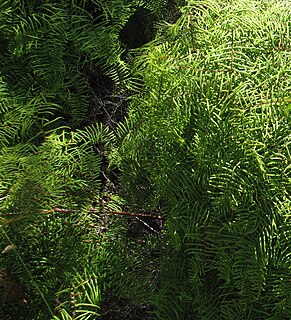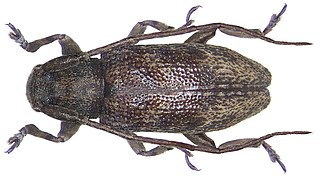
Glycyrrhiza is a genus of about 20 accepted species in the legume family (Fabaceae), with a subcosmopolitan distribution in Asia, Australia, Europe, and the Americas.
Baccalena squamulosa is a species of air-breathing land snail, a terrestrial pulmonate gastropod mollusk in the family Camaenidae. This species is endemic to Australia.

Aglaia squamulosa is a species of plant in the family Meliaceae. It is found in Indonesia, Malaysia, and the Philippines.
Arachniodes squamulosa is a species of fern in the family Dryopteridaceae. It is endemic to Ecuador. Its natural habitats are subtropical or tropical moist lowland forests and subtropical or tropical moist montane forests. It is threatened by habitat loss.

Ardisia squamulosa is a species of plant in the family Primulaceae. It is endemic to the Philippines. It is used to flavor fish.
Horsfieldia squamulosa is a species of plant in the family Myristicaceae. It is endemic to Papua New Guinea.
Knema squamulosa is a species of plant in the family Myristicaceae. It is endemic to Vietnam.

Villadia is a genus of plants in the family Crassulaceae. It includes about 25 to 30 species distributed from Texas to Peru.

Ropica Górna is a village in the administrative district of Gmina Sękowa, within Gorlice County, Lesser Poland Voivodeship, in southern Poland, close to the border with Slovakia. It lies approximately 4 kilometres (2 mi) east of Sękowa, 9 km (6 mi) south-east of Gorlice, and 108 km (67 mi) south-east of the regional capital Kraków.

Gleichenia is a genus of ferns. Its closest relative is the genus Stromatopteris, restricted to New Caledonia.

Alyxia squamulosa, commonly known as alyxia vine, is a species of shrub in the family Apocynaceae. It is endemic to Australia’s subtropical Lord Howe Island in the Tasman Sea. The specific epithet derives from the many bracteoles, or ‘scales’ that subtend the flowers. The plant previously known as Alyxia lindii is considered a taxonomic synonym of A. squamulosa, being reassigned in 2002.

Ropica is a genus of beetles in the family Cerambycidae, containing the following species:
Ropica albomarmorata is a species of beetle in the family Cerambycidae. It was described by Breuning in 1939.
Ropica sumatrensis is a species of beetle in the family Cerambycidae. It was described by Breuning in 1939.
Ropica kaszabi is a species of beetle in the family Cerambycidae. It was described by Breuning in 1975.
Ropica sechellarum is a species of beetle in the family Cerambycidae. It was described by Breuning in 1957. It contains the subspecies Ropica sechellarum interruptefasciata and Ropica sechellarum sechellarum.
Ropica duboisi is a species of beetle in the family Cerambycidae. It was described by Fairmaire in 1850.
Ropica formosana is a species of beetle in the family Cerambycidae. It was described by Henry Walter Bates in 1866. It contains four subspecies, Ropica formosana formosana, Ropica formosana japonica, Ropica formosana nobuoi, and Ropica formosana tokaraensis.
Diadelia squamulosa is a species of beetle in the family Cerambycidae. It was described by Breuning in 1940.

Coralliophila squamulosa is a species of sea snail, a marine gastropod mollusk, in the family Muricidae, the murex snails or rock snails.








